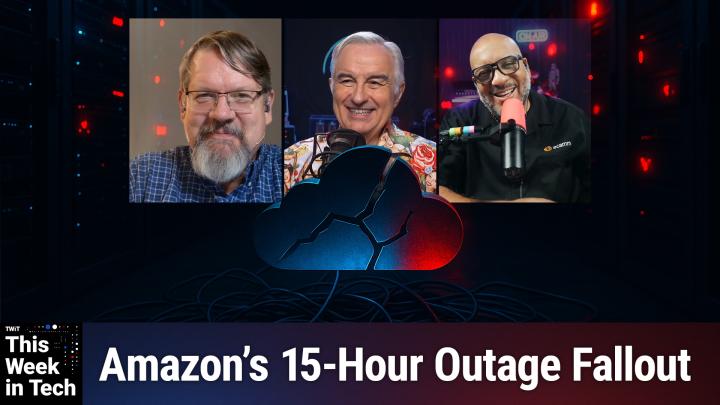Episode Transcript
How Dependent Are We on AWS? Lessons from the 15-Hour Amazon Outage
Oct 28th 2025
AI-generated, human-reviewed.
A recent 15-hour outage at Amazon Web Services (AWS) exposed critical vulnerabilities affecting thousands of businesses, apps, and even smart home products worldwide. On This Week in Tech, host Leo Laporte, alongside guests Doc Rock and Richard Campbell, dissected the outage's technical root cause, its far-reaching impacts, and practical lessons for tech teams.
Why Did the Amazon Outage Happen? The Technical Breakdown
The AWS outage centered on US-EAST-1, one of Amazon's oldest and most heavily used cloud regions located in Northern Virginia. A race condition within the DNS (Domain Name System) management system for DynamoDB—Amazon's scalable database service—caused conflicting automated processes to delete critical DNS records.
Specifically, the race condition occurred when two independent DNS automation components applied conflicting DNS plans to route traffic. A cleanup process then deleted all IP addresses for DynamoDB's regional endpoint, leaving the system in an inconsistent state that automated recovery couldn't fix.
With no valid DNS configuration, vast numbers of cloud-hosted services—ranging from Snapchat and Roblox to Eight Sleep smart mattresses and internet-enabled devices—lost connectivity. This created a cascading failure; even after the initial DNS issue was resolved, many systems remained impaired for hours as they worked through massive backlogs.
Technical Terms Explained:
- Race Condition: An unpredictable error where two system processes compete for the same resource, causing unstable or lost data.
- DNS (Domain Name System): The system that translates user-friendly web addresses into actual server IP addresses.
- DynamoDB: Amazon's managed NoSQL database service; a critical dependency for many cloud-based applications.
How Did This Affect Everyday Services and Consumers?
As covered on the show, the impact wasn't limited to app developers or IT teams—it also hit everyday consumers. Everything from smart mattresses failing to adjust temperature settings to entertainment platforms and connected devices suddenly went offline. Leo and Doc noted the surprise when everyday home gadgets—like sleep trackers and smart home devices—revealed their heavy reliance on AWS connectivity.
This incident demonstrated how deeply modern life depends on cloud infrastructure for even the simplest daily functions. With one region down, devices and services worldwide were paralyzed.
Is Cloud Computing Too Centralized? What Experts Say
Richard Campbell highlighted a critical point: many global apps and services rely almost exclusively on a specific AWS region (US-EAST-1). When that region fails, entire worldwide technology stacks can be paralyzed. Doc Rock explained how AWS's physical data centers in places like Virginia essentially "control the world behind the trees."
The discussion turned toward whether businesses have become dangerously reliant on single cloud providers or have inadequately configured fallback systems. Many organizations discovered they lacked proper "multi-region" configurations to gracefully switch to a backup location when disaster strikes.
Lessons for Companies:
- Always build redundancy across cloud regions, not just vendors
- Test failover systems regularly—not only during disasters
- Configure critical apps to "degrade gracefully" if cloud connectivity fails
- Understand the full dependency chain of your infrastructure
How Can Businesses and Users Become More Resilient?
The experts suggested assessing current cloud setups for:
- Single points of failure: Any region, provider, or service without a backup pathway
- True multi-region failover: Not just multiple services, but multiple, geographically diverse hubs
- Offline functionality: Ensure devices have local fallback options (e.g., manual controls, local storage)
- Testing scenarios: Simulate losing your main cloud connectivity—can your business or home survive?
Campbell recommended businesses re-evaluate their IT configuration after such incidents.
Key Takeaways
- The AWS outage exposed the risks of centralized cloud infrastructure, affecting global apps, smart products, and critical systems
- A race condition in DynamoDB's DNS management automation led to a 15-hour outage, with cascading failures across dependent services
- Millions of devices and users worldwide rely on a single AWS region—US-EAST-1—for foundational cloud services
- Most organizations were unprepared with proper multi-region failover, highlighting the need for better cloud architecture
- Even household products can be immobilized when cloud access fails. Offline backups and local controls are essential
- Resilience means planning for any cloud region (or vendor) failure and testing your systems frequently
- The outage demonstrates that recovery from distributed system failures takes much longer than fixing the root cause alone
The Bottom Line
The AWS outage highlighted how deeply intertwined our tech-driven lives are with cloud infrastructure—and how a single technical flaw can disrupt services worldwide. Businesses and consumers must push for smarter multi-region configurations, offline resiliency, and continuous testing to safeguard against the next inevitable cloud disaster.
Don’t wait until the next outage to fix your systems. For more expert analysis and weekly tech news, subscribe to This Week in Tech: https://twit.tv/shows/this-week-in-tech/episodes/1055
